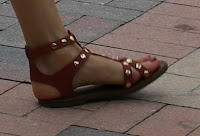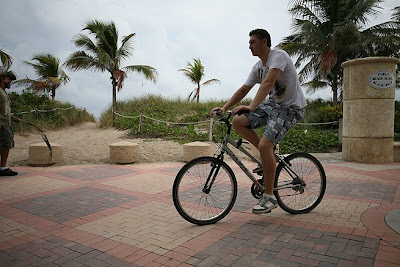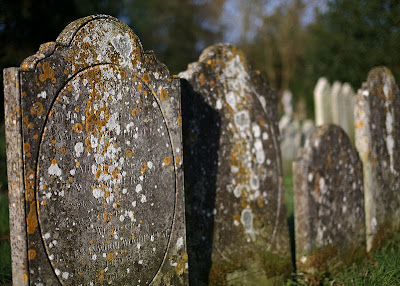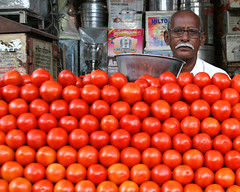Exercise: Shutter speeds.
There are three main variables that affect the exposure of a photograph, aperture, shutter speed and film/sensor ISO rating. We have looked at the effect of aperture on a scene and how it alters the depth of field but when changing the aperture either the shutter speed or the ISO rating is going to have to change as well in order to keep the exposure correct. With changing aperture the most common variable to alter is the shutter speed, particularly when shooting a static scene from a tripod as was done in the Focus Exercise.
This exercise looks at how changing shutter speeds affect moving subjects. I chose a frequently used beach path at the edge of South Beach in Miami, FL, USA. The camera was set onto a tripod and I took photographs of people as they passed the lens. I chose a moderate wide angle of 30mm to get good coverage of the area and good depth of field.
1/8, f22, ISO50, 30mm.
At a slow walking speed, photographed with a shutter speed of 1/8th sec, almost any movement of the people results in motion blur. What this means is that while the shutter was open, part of the image presented to the sensor was moving sufficient for it to be registered in several different positions during the exposure. Obviously, the faster the moving object, the more motion blur is observed e.g. the peoples legs. The background behind the moving legs is only obscured for a small part of the exposure so there is sufficient time for it to register on the sensor once the leg is out of the way. This leads to the ghosting (semi transparency) of that part of the image. An object that moves fast enough through a frame shot at a slow speed may not register at all. The only part of our walking people that isn't blurred are the feet that are in contact with the ground during the exposure. Relative to a stationary camera, a foot that is on the ground moves at the same speed as the ground i.e. not at all, and therefore shows no motion blur. Without the aid of a Neutral Density filter, using the slowest ISO setting of 50 and the smallest aperture of f22, 1/8th sec was the slowest speed that the available light would allow.

1/10, f22, ISO50, 30mm.
There is very little change between 1/8th and 1/10th (one third of a stop) but despite being slightly faster the person here is considerably more blurred. I would hope that the reason is fairly obvious, they are moving faster. However, the subjects speed isn't the thing that creates blur, it is their movement relative to the camera. An airliner flying past a long way away may well be flying at 400 mph but because of it's distance from the camera it only crawls past and may not blur, whereas a person running at only 5 mph but close to the camera is gone in a second and will be completely blurred. The runner here is going fast enough for even their grounded foot to move during the shot.
1/15, f18, 30mm, ISO50.
At a 15th of a second we are approaching speeds that can be carefully hand-held if a little camera shake isn't a worry (however in this sequence a tripod is used throughout). Walking people are recognisable as such, whereas the running lady remains a one legged blur.
Both at 1/30, f11, 30mm, ISO50.
At 1/30th very small amounts of movement are sharp so the man and dog in the appear unblurred. In the other photo it can be seen that, although they are not completely sharp, the walking couple are becoming acceptably clear. The running man, however, remians well blurred. A 1/30th is usually the slowest speed it is acceptable to attempt a hand held photograph.
1/60, f10, 30mm, ISO50.
At 1/60th the images are a combination of sharp on those parts of the body that are moving relatively slowly and a little blur on swinging arms and feet. This is a good shutter speed to show a little motion blur to emphasise the movement of a subject.
1/60, f10, 30mm, ISO50.
Whilst slowly moving objects may be starting to become sharp at 1/60th, a faster object like this cyclist is still moving too quickly to become frozen. However, the couple walking down the path towards the camera are nice and sharp as can be seen in the blow-up below. This is due to their slow speed and because they are moving towards the camera giving very little relative motion.
Enlargement from photograph above.
1/125, f7.1, 30mm, ISO50.
In this composite shot taken at 1/125th even the fairly fast moving cyclist is becoming less blurred. The spokes in the wheels are starting to be visible but much of the rest of the subject still shows motion blur. Of interest, the pedals show no more blur than the rest of the body as the bike is moving just as fast as the pedals are going around.

1/200, f5.0, 30mm, ISO50.
Enlargement from photograph above.
At 1/200th the cyclist is almost sharp everywhere and now the amount of enlargement starts to become a factor in determining the level of blur. A small picture might well appear sharp but on enlargement areas of motion blur may become obvious as can be seen in this section of the original photograph.
1/200, f5.0, 30mm, ISO50.
Shot at the same speed as the previous example, it is worth noticing that a walking person is now nicely sharp with only tiny areas of motion blur obvious, such as on the left foot, whereas the right foot is pin sharp. 

The left foot
The right foot
1/400, f8, 30mm, ISO200
An enlargement from the above photograph.
As I bring the speed up to 1/400th we can see very little evidence of motion blur at all. An enlargement, however, reveals that even at this speed a small amount of blurring still occurs when compared with the static background. An astute observer will have noticed that as the shutter speed has increased during this series of photos, the aperture has increased in size to compensate for the reduction of exposure time. On this photograph the aperture limit was reached and the only recourse was to increase the ISO rating from 50 to 200 to regain the status quo.
1/2500, f4, 30mm, ISO200.
An enlargement from the above photograph
For this final photograph I cranked the speed up to a generous 1/2500th and truly froze the action. Bear in mind that the subject isn't moving particularly fast when compared with photographing something like motor sport. For faster subjects a panning technique is almost essential and I will explore this in my next Exercise.








































